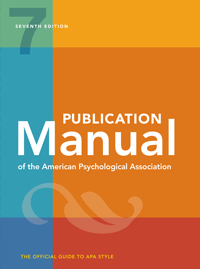Citation Help: APA 7th Edition
A Brief Intro to APA
What is it?
- APA style refers to a specific formatting style created by the American Psychological Association.
- APA is most commonly used by students and scholars in the social sciences when writing papers and citing sources.
- This guide includes information and examples based on the most recent 7th (2020) edition.
How does APA work?
- APA Style most commonly uses a brief in-text citation and a full citation on a reference page.
-
APA Style is a “down” style, meaning that words are lowercase unless there is specific guidance to capitalize them. Capitalize the first word of a sentence, unless the sentence begins with the name of a person whose name starts with a lowercase letter.
Where can I find Examples?
- Examples of APA citations can be found by source in the box on below or from the drop-down APA menu.
What you'll find in the APA Publication Manual - 7th Edition
Publication Manual of the American Psychological Association
The Publication Manual of the American Psychological Association is broken down into twelve parts covering all aspects of publishing.

Section 1: Scholarly Writing and Publishing Principles
This section introduces the different types of articles, including quantitative and qualitative reviews, as well as student papers. This section also discusses the ethical, legal, and professional standards in publishing. These standards involve ensuring the accuracy of findings, protecting research participants, and protecting intellectual property rights.
Section 2: Paper Elements and Format
This section goes over the elements of a paper including examples. Consistency allows readers of APA papers to focus on content rather than presentation.
Section 3: Journal Article Reporting Standards
Reporting standards are guidelines to help authors make their research clear and accurate. Practical guidelines make the process transparent for the readers as well, and this chapter contains the guidance.
Section 4: Writing Style and Grammar
To help with clear communication, this section aims to provide guidance on effective scholarly writing. Information on grammar like appropriate verb tense is also included. This chapter can help writers create more effective and powerful pieces.
Section 5: Bias-Free Language Guidelines
The APA emphasizes an avoidance of bias in writing. This section shares both general guidance on how to reduce bias, as well as specific recommendations for reducing bias by topic.
Section 6: Mechanics of Style
This section goes over sale guidelines that create a consistent presentation in written work. This involves the technical aspects like what to do regarding capitalization, spelling, using numbers, etc.
Section 7: Tables and Figures
This section goes over why tables and figures are used, how to use them, and how to reproduce them, as well as providing examples.
Section 8: Works Credited in the Text
Crediting work in text is a crucial part of writing in APA style, and this section shows guidances on in-text citations. It gives formats for different sources, explains the difference between quoting and paraphrasing, and has examples for many situations.
Section 9: Reference List
This section goes over how to create a reference list with explanations of each part of it.
Section 10: Reference Examples
This section is full of different sample references for your reference list. It also provides information if the sources vary from the samples.
Section 11: Legal References
Citing legal material can be a different process than other sources, so this section gives further information on that.
Section 12: Publication Process
Guidance is provided in the section on how the publication process works, including rules around copyright and permissions for reprinting.
Available for purchase in print and as an e-book